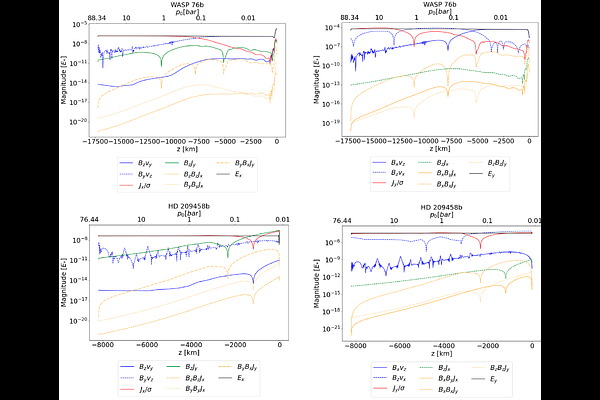Non-ideal MHD simulations of hot Jupiter atmospheres

Non-ideal MHD simulations of hot Jupiter atmospheres
Clàudia Soriano-Guerrero, Daniele Viganò, Rosalba Perna, Albert Elias-López, Hayley Beltz
AbstractIn Hot Jupiters (HJs), atmospherically induced magnetic fields are expected to play an important role in controlling the wind circulation and in determining their inflated radii. Here we perform 1D plane-parallel magnetohydrodynamic (MHD) simulations of HJ atmospheric columns, using the wind and thermodynamic profiles generated by global circulation models of different exo-planets. We quantitatively investigate the effects of magnetic field winding and Ohmic dissipation (previously considered in several works), with the addition of Hall drift and ambipolar diffusion. The main effect is the magnetic field winding in the full non-linear regime, with local azimuthal fields reaching maximum values up to ${\cal O}(10^2)$ G at the shear layer (typical pressure $\sim 1$ bar), much stronger than the assumed background field generated in the planetary interior. The associated meridional currents undergo Ohmic dissipation, with local heating efficiencies of at least $\sim$ ${10^{-6}}-10^{-3}$ (considering only these shallow layers). In addition to the dominant winding vs. Ohmic balance, the presence of the Hall and ambipolar terms have a non-negligible contribution in shaping and twisting the induced magnetic field at $p\lesssim 1$ bar; however this effect is only apparent for the hottest planets. Our results, though limited by construction to a plane-parallel approximation of the sub-stellar columns and with a simplified setup that cannot consistently include the magnetic drag on the wind, assess the non-linearity and complexity of the magnetic induction in HJs atmospheres, and call for a self-consistent inclusion of MHD effects in Ohmic dissipation studies and circulation models, beyond the often-assumed perturbative regime.